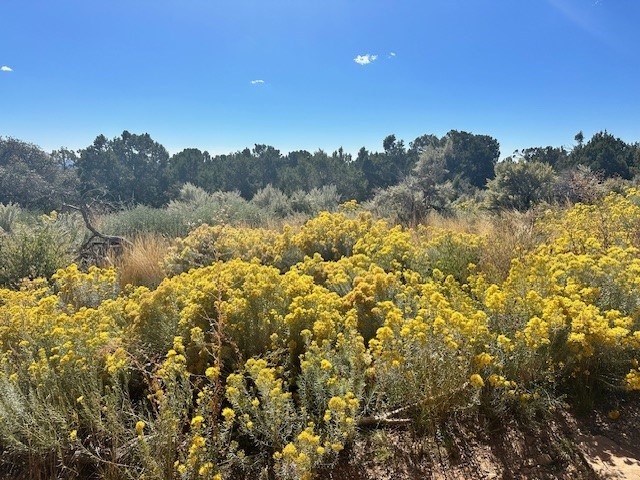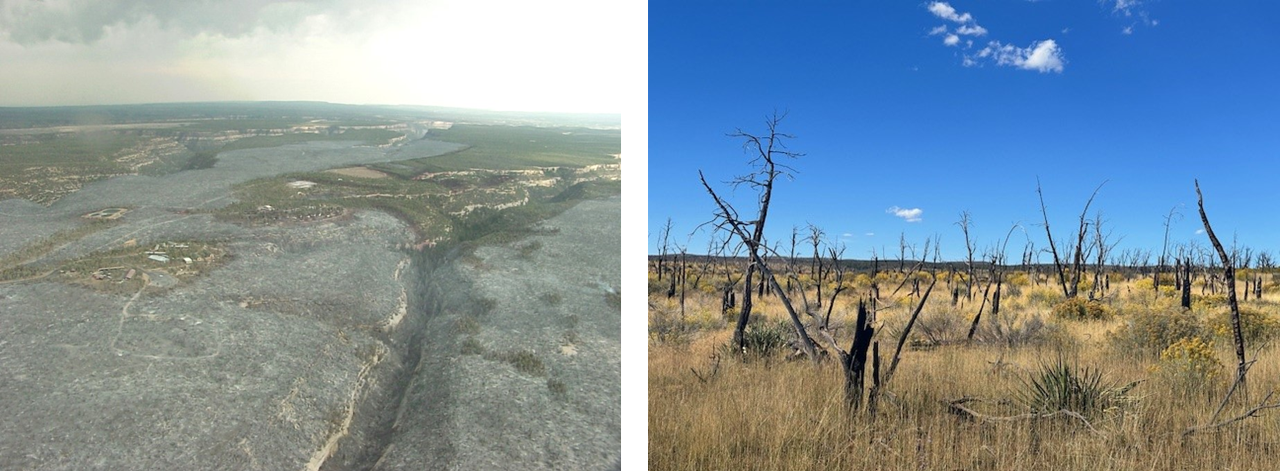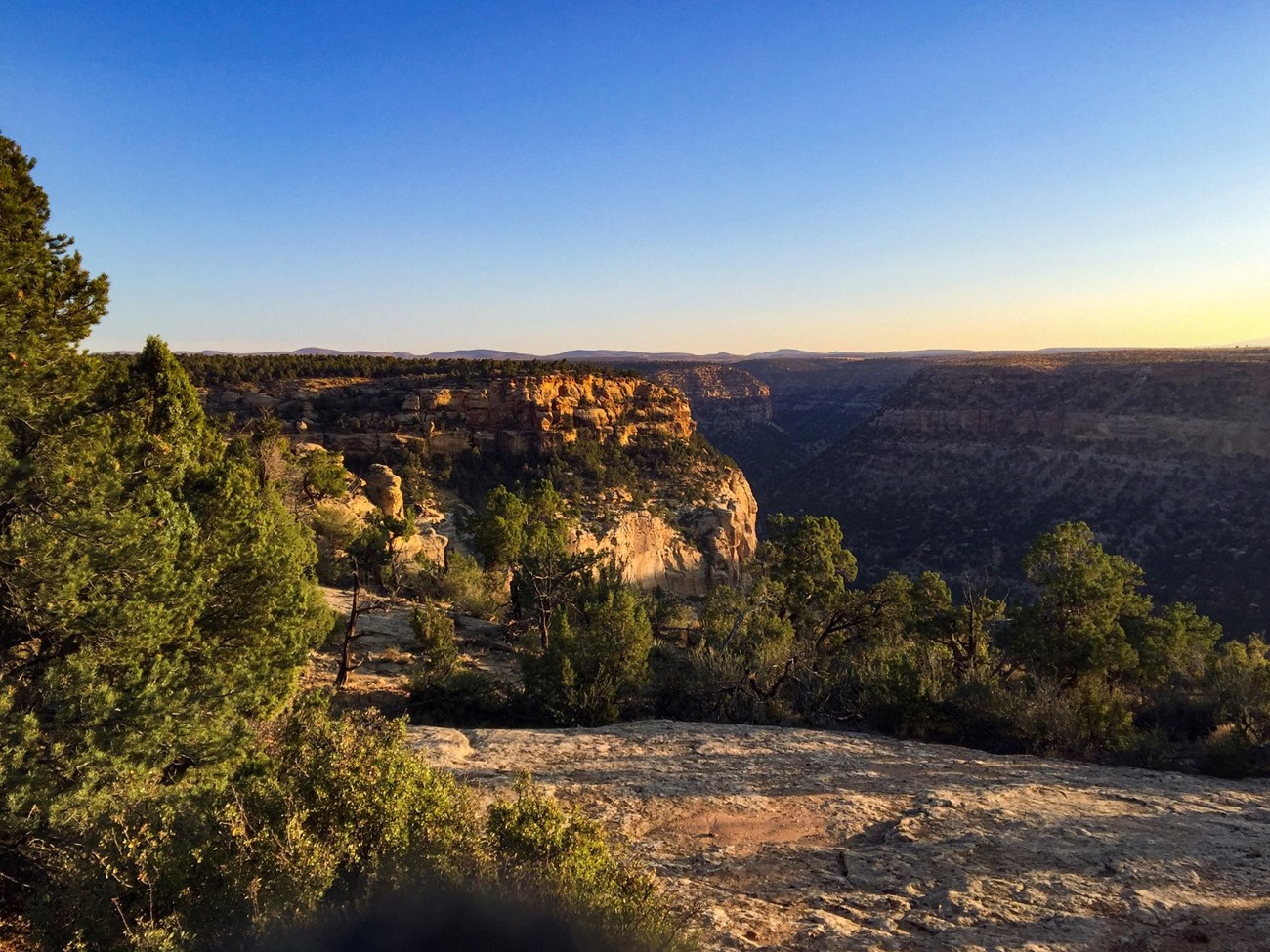Part of a series of articles titled Condition of Selected Natural Resources at Mesa Verde National Park: A 2025 Assessment.
Article
The Condition of Pinyon-Juniper Woodlands and other Upland Communities at Mesa Verde National Park, 2025
A 2025 Natural Resource Condition Assessment evaluated six resources at Mesa Verde National Park. This article describes what we learned about upland vegetation.

NPS / Tammy Cook
Upland Vegetation was one of six resources included in the 2025 Natural Resource Condition Assessment (NRCA) for Mesa Verde National Park (NP). Mesa Verde has a number of upland vegetation types. For this study, the NRCA team, led by Conservation Science Partners, carried out a gap analysis for upland vegetation in general, and a condition assessment for unburned pinyon-juniper woodlands. A gap analysis highlights what we know and don’t know about a resource, while a condition assessment is a more thorough evaluation of a resource’s current condition. You can read about the intent of the NRCA project and the other resources assessed for Mesa Verde in an overview article.
Uplands at Mesa Verde: Mostly Woodlands and Shrublands
Upland vegetation types at Mesa Verde NP include pinyon-juniper (PJ) woodlands, which support a high level of biodiversity and provide essential ecosystem services (Rondeau et al. 2011). PJ woodlands in the park consist of two-needle pinyon pine (Pinus edulis) and Utah juniper (Juniperus osteosperma). They occur on most mesas and upper canyon slopes up to 7,870 feet (2,400 meters) in elevation (Thomas et al. 2009). Fire has played an important role in shaping plant communities in the park, especially in PJ communities.
Another ecologically important upland vegetation type in the park is mountain shrubland. This type has become more common in recent years. In Mesa Verde this community is characterized by the prevalence of Gambel oak (Quercus gambelii), although other shrubland species, like Utah serviceberry (Amelanchier utahensis), cliff fendlerbush (Fendlera rupicola), and mountain mahogany (Cercocarpus montanus), may co-dominate (Thomas et al. 2009). Mountain shrubland is found at elevations of about 6,750 to 8,500 feet (2,100–2,600 meters) and where soils are deep and well developed. When disturbances like fire remove above-ground stems, oak and serviceberry are quick to resprout, demonstrating the fire-adapted nature of these species (Kaufmann et al. 2016).
In other areas of Mesa Verde, such as the eastern portion, there is a patchy mosaic of woodlands and shrublands mixed with species such as Gambel oak, mountain snowberry (Symphoricarpos oreophilus), and cliff fendlerbush (Thomas et al. 2009). The park also has less common upland vegetation types, such as shrub-steppe. This community is dominated by big sagebrush (Artemisia tridentata), which occurs at lower elevations in many of the canyon bottoms, in some areas where fire has removed PJ canopy, and in the mountain shrubland-PJ woodland ecotone (Thomas et al. 2009). Douglas fir (Pseudotsuga menziesii) and ponderosa pine (Pinus ponderosa) stands, which occur at higher-elevation side-canyon areas in the park, have been greatly reduced since fires in the early 2000s.
Upland Vegetation Gap Analysis
To assess upland vegetation at Mesa Verde NP, the NRCA team focused on three main aspects of the vegetation: change in vegetation cover across broad categories; recovery of vegetation communities after fire; and change in non-native plant cover over time. They used information from several sources to complete the gap analysis.
Change in Vegetation Cover
The NRCA team used the Rangeland Analysis Platform (RAP), which is a dataset modeled from long-term Landsat imagery. The data can reveal changes in broad categories of vegetation cover and indicate transitions in plant communities. The analysis of RAP data revealed a general trend of declining tree cover and increasing shrub cover in the park since the mid-1980s to the present.
Recovery After Fire
The NRCA team considered the effects of fire on Mesa Verde’s upland vegetation communities, primarily through the use of the park’s Long Term Post Fire Monitoring Program (LTPFMP) reports, and recent research conducted by Phillips et al. (2023).
For the LTPFMP, researchers established 53 plots that had burned in one of two fires (Pony Fire in 2000 and Long Mesa Fire in 2002). They collected data in 2011–2014 and 2019. Among their observations were that burned landscapes in the earlier years were dominated by native and non-native grasses, with native shrubs becoming more prevalent almost 20 years post-fire. In 2019, sites from both fires were still in the early stages of succession with little PJ recruitment.
The Phillips et al. (2023) work concluded that it is unlikely that Mesa Verde’s PJ would recover on its own following both fires. Reasons for this include increased grass cover, which makes the area more flammable. Also, climate changes lead to lower soil moisture, which negatively affects seed germination and seedling establishment.

NPS (left), NPS / Tammy Cook (right)
Change in Non-native Plant Cover After Fire
To study changes in non-native plant cover, the NRCA team used data from the RAP dataset (1987–2023), along with GIS data provided by park biologists and information from NPS Invasive Plant Monitoring Plan reports.
The NRCA team found that non-native annual forbs and grasses covered more area after stand-replacing fires than before. Non-native plants likely increased post-fire because they recover faster than native species and get a competitive advantage with the availability of bare soil (Floyd et al. 2006). Floyd et al. (2021) found lower densities of non-native species in burned mountain shrub habitats compared to burned PJ habitats. Overall, post-fire invasion of grasses, along with climate change, creates undesirable conditions for PJ regeneration. This may lead to a shift from PJ woodlands to habitats dominated by perennial grasses and shrubs.
Pinyon-Juniper (PJ) Woodlands Condition Assessment
PJ Woodlands are Old and Slow to Recover
The PJ woodlands at Mesa Verde NP include remnant old growth stands that are 300 to 500 years old (Turner et al. 2007), with some individual trees more than 500 years old (Floyd et al. 2003). It is thought that historically, persistent PJ woodlands in this part of the Colorado Plateau experienced infrequent, high-severity crown fires every 400 years or more (Floyd et al. 2004, Turner et al. 2007). After stand-replacing fires, woodland regeneration is slow—requiring many decades for new trees to re-establish (Floyd et al. 2000).
In recent years, severe fires have burned a large portion of the park’s PJ woodlands. From 1996 to 2006, two-thirds of these woodlands experienced fire (Turner et al. 2007). In many of these areas it is still too early to see PJ woodlands return.

NPS
How are unburned PJ woodlands in Mesa Verde doing?
To assess unburned woodlands, the NRCA team used the NPS Southern Colorado Plateau Network’s (SCPN’s) long-term dataset (2008–2022) and related analyses from monitored vegetation and soils in the park’s unburned PJ woodlands (Swan 2024). There were a total of 60 monitoring plots. The plots, and therefore analyses, were separated according to two soil types—referred to as the Loamy PJ Ecological Site (or Ecosite) and Shallow Loamy PJ Ecosite. Both of the ecosites were in old growth PJ woodlands, with limited understory vegetation, very old trees (>400 years old), and historically long fire-return intervals.
The NRCA team used seven indicators of PJ condition. They also used specific criteria to determine whether condition was good, fair, poor, etc. for each indicator. When possible, these criteria were quantitative, but qualitative criteria may also be used. In general, the indicators ranked well. Across the two soil types, the following indicators ranged from good/fair to good condition:
- Shrub cover
- Perennial grass cover
- Annual grass cover
- Species richness
- PJ canopy cover
Two of the seven indicators ranked lower:
- Forb cover ranked as good/fair in the Loamy PJ Ecosite and fair in the Shallow Loamy site.
- Pinyon seedling recruitment ranked as fair in the Loamy PJ Ecosite and fair/poor in the Shallow Loamy site.
This last finding is concerning, because all SCPN monitoring plots were in unburned sites. This may suggest potential future problems with pinyon recruitment in the park, even in the absence of fire. Swan (2024) and the NRCA team provided information on trends for six of the seven indicators for both of the ecosite types. In nearly every case the trend was stable or improving, which is good news.
What can park managers do with this information?
The assessment will help guide stewardship and management of upland vegetation in Mesa Verde NP. Knowing the condition of these resources and what information is lacking is only the first step. Study findings are also linked to actions park managers can take to better conserve the resources. For this reason, the NRCA team developed management considerations. A few are included here:
- Continue the study by Phillips et al. (2023) to further understand the long-term effects of thinning in pinyon-juniper communities. Phillips et al. (2023) discussed the effects of thinning treatments within burned and intact PJ stands in the park. These researchers found that thinning the vegetation may help to resist habitat type conversion by reducing future fire risk. However, there may also be unintended ecological consequences.
- Increase monitoring and documentation of past treatment efforts for non-native plants to determine effectiveness. This includes mapping the aerial extent of infested areas one year after treatment, whether the target species are alive or dead within the area, and an estimate of non-native plant density within those areas.
- Continue collecting native seeds and consider planting native shrubs in areas at risk from invasive grasses after fire. The park has a program for collecting native seeds, including rare and endemic plant seeds, for revegetation projects (Knight et al. 2021). Mesa Verde managers might also plant native shrubs in the areas most at risk of weed invasion after a fire. This is partly because native shrubs can help pinyon pine seedlings grow better (Floyd et al. 2006).
References
Floyd, M. L., W. H. Romme, and D. D. Hanna. 2000. Fire history and vegetation pattern in Mesa Verde National Park, Colorado, USA. Ecological Applications 10(6):1666–1680. Available at https://doi.org/10.2307/2641230.
Floyd, M. L., M. Colyer, D. D. Hanna, and W. H. Romme. 2003. Gnarly old trees: Canopy characteristics of old-growth pinon–juniper woodlands. In Ancient pinon–juniper woodlands. (pp. 11–30). University Press of Colorado.
Floyd, M. L., D. D. Hanna, and W. H. Romme. 2004. Historical and recent fire regimes in pinyon-juniper woodlands on Mesa Verde, Colorado, USA. Forest Ecology and Management 198(1–3):269–289. Available at https://doi.org/10.1016/j.foreco.2004.04.006.
Floyd, M. L., D. Hanna, W. H. Romme, and T. E. Crews. 2006. Predicting and mitigating weed invasions to restore natural post-fire succession in Mesa Verde National Park, Colorado, USA. International Journal of Wildland Fire 15(2):247–259.
Floyd, M. L., W. H. Romme, and D. H. Hanna. 2021. Effects of recent wildfires in piñon-juniper woodlands of Mesa Verde National Park, Colorado, USA. Natural Areas Journal, 41(1):28-38. Available at https://doi.org/10.3375/043.041.0105.
Kaufmann, M. R., D. W. Huisjen, S. Kitchen, M. Babler, S. R. Abella, S. Gardiner, D. McAvoy, J. Howie, and D. H. Page, Jr. 2016. Gambel oak ecology and management in the southern Rockies: The status of our knowledge. SRFSN Publication 2016-1. Fort Collins, Colorado, Southern Rockies Fire Science Network.
Phillips, M. L., C. Lauria, T. Spector, J. B. Bradford, C. Gehring, B. B. Osborne, A. Howell, E. E. Grote, R. J. Rondeau, G. M. Trimber, B. Robinson, and S. C. Reed. 2023. Trajectories and tipping points of pinyon-juniper woodlands after fire and thinning. Global Change Biology 30(2), e17149. Available at https://doi.org/10.1111/gcb.17149.
Rondeau, R., K. Decker, J. Handwerk, J. Siemers, L. Grunau, and C. Pague. 2011. The state of Colorado’s biodiversity 2011. Prepared for The Nature Conservancy. Colorado Natural Heritage Program, Colorado State University, Fort Collins, Colorado. Available at https://www.academia.edu/68916940/State_of_Colorados_biodiversity_2011_The.
Swan, M. 2024. Vegetation trends in pinyon-juniper woodlands in Southern Colorado Plateau Network parks. NPS, Southern Colorado Plateau Network.
Thomas, K. A., M. L. McTeague, L. Ogden, M. L. Floyd, K. Schulz, B. A. Friesen, T. S. Fancher, R. G. Waltermire, and A. Cully. 2009. Vegetation classification and distribution mapping report: Mesa Verde National Park. Natural Resource Report (NPS/SCPN/NRR—2009/112). National Park Service. Available at https://pubs.usgs.gov/publication/70194406.
Turner, C. E., W. H. Romme, J. Chew, M. E. Miller, G. Leavesley, L. Floyd-Hanna, G. San Miguel, N. Cobb, R. Zirbes, R. Vigor, and K. Ironside. 2007. The FRAME project—A collaborative modeling approach to Natural Resource Management at Mesa Verde National Park, Colorado. In The Colorado Plateau III: Integrating research and resources management for effective conservation.
Last updated: June 25, 2025
